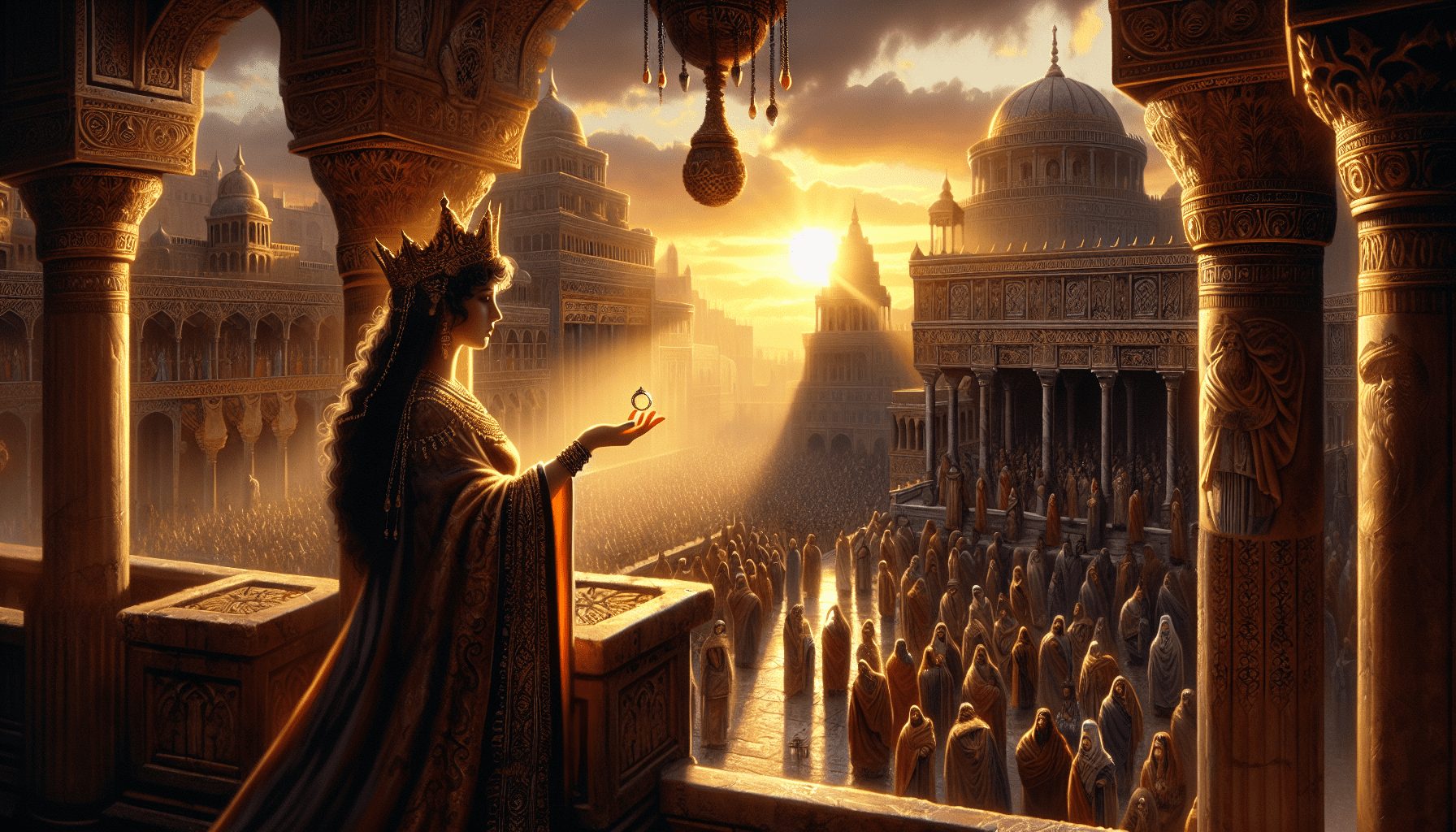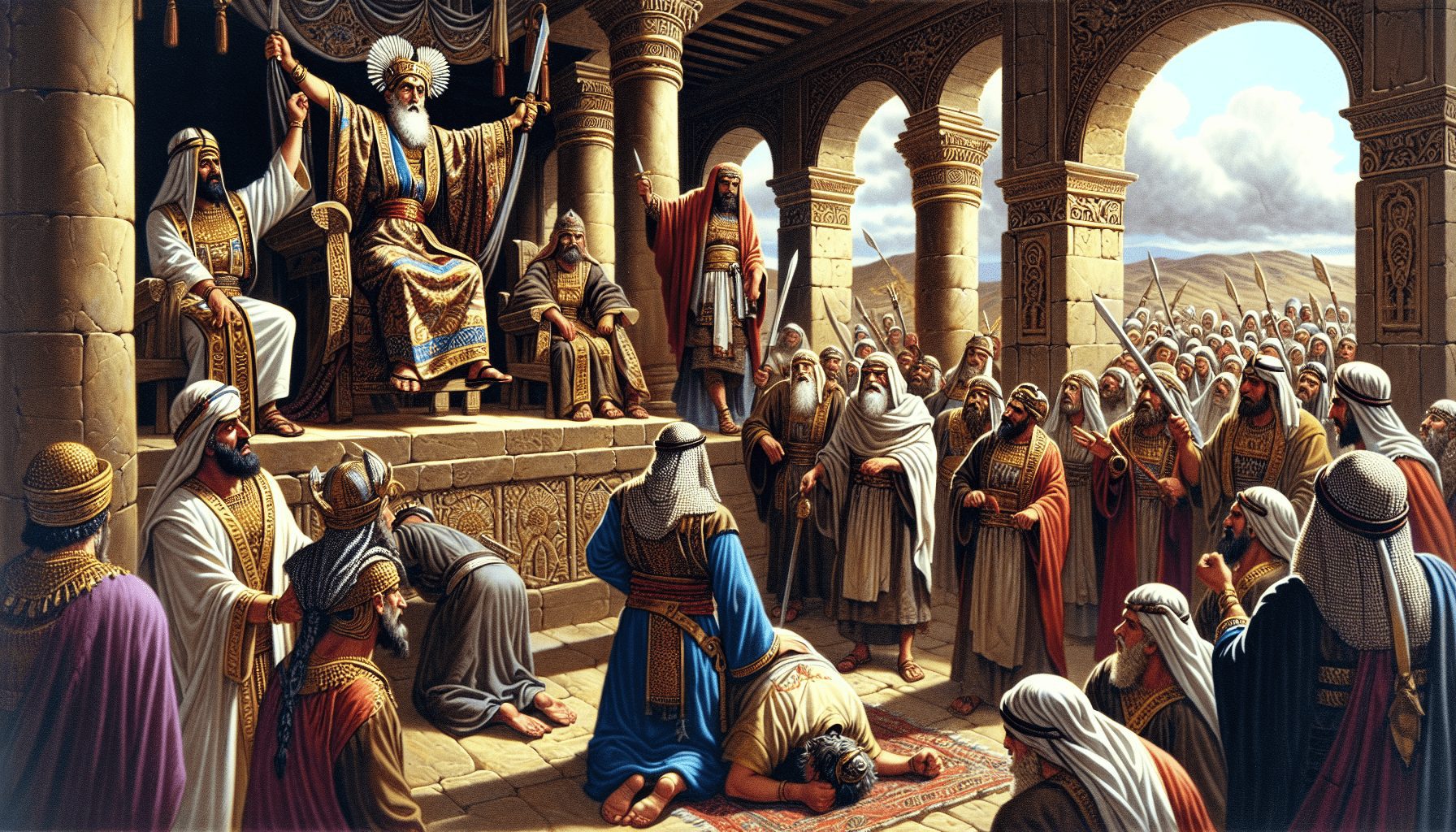**The Triumph of Esther and the Salvation of the Jews**
The sun rose over the citadel of Susa, casting golden rays upon the marble palaces and bustling streets of the Persian Empire. The air was thick with anticipation, for the fate of an entire people hung in the balance. Queen Esther, the Jewish queen who had risked her life to reveal Haman’s wicked plot, now stood before King Ahasuerus once more. Her heart was heavy, yet resolute, for though Haman had been executed, his evil decree against the Jews remained. The king’s signet ring, once wielded by Haman to seal their doom, now rested in Mordecai’s hand, but the edict written in the king’s name could not be undone. Esther knew that only divine intervention and the king’s favor could save her people.
With grace and humility, Esther approached the throne. Her royal robes shimmered in the morning light, but her face bore the weight of her burden. She fell at the king’s feet, tears streaming down her cheeks. “If it pleases the king,” she pleaded, her voice trembling yet firm, “and if I have found favor in his sight, let an order be written to revoke the letters devised by Haman, which he wrote to destroy the Jews in all the king’s provinces. For how can I bear to see the calamity that will come upon my people? How can I endure the destruction of my kindred?”
King Ahasuerus, moved by Esther’s anguish, extended his golden scepter to her. “Esther, my queen,” he said gently, “you have already risked your life for your people, and your courage has not gone unnoticed. Haman’s house has been given to you, and Mordecai has been elevated to his position. But as you know, an edict sealed with the king’s signet ring cannot be revoked. However, I grant you and Mordecai the authority to write a new decree in my name. Use my ring to seal it, and may it bring deliverance to your people.”
Esther’s heart swelled with gratitude, and she bowed low before the king. “Thank you, my lord,” she whispered. “Your mercy and wisdom will be remembered forever.”
Mordecai, now clothed in royal garments of blue and white, a golden crown upon his head, was summoned to the palace. Together with Esther, he crafted a new decree, one that would empower the Jews to defend themselves against their enemies. The scribes were called, and the decree was written in every language of the empire, from India to Ethiopia. It was sealed with the king’s signet ring and sent swiftly by couriers on horseback, mules, and camels, racing to every corner of the vast kingdom.
The decree proclaimed that the Jews were granted the right to assemble and protect themselves, to destroy, kill, and annihilate any armed force that might attack them, their women, and their children. They were also permitted to plunder the property of their enemies. The date set for this defense was the thirteenth day of the twelfth month, the very day Haman had chosen for their destruction.
As the couriers rode out, the Jews in every province rejoiced. The news spread like wildfire, igniting hope in hearts that had been shrouded in despair. In Susa, the city erupted in celebration. The streets were filled with laughter, songs, and prayers of thanksgiving. Mordecai, now second only to the king, walked through the city in his royal robes, his face radiant with joy. The Jews honored him, for they knew that through his wisdom and Esther’s courage, their deliverance had come.
Esther returned to her chambers, her spirit lifted but her work not yet complete. She knelt in prayer, thanking the God of Israel for His faithfulness. She knew that the battle was not over, but she trusted in the Lord’s providence. The Jews would now have the means to defend themselves, and she believed that the Almighty would fight for them.
In the days that followed, the Jews prepared for the appointed day. They fasted, prayed, and armed themselves, ready to face their enemies. The fear of the Jews fell upon the people of the empire, for they saw that the God of Israel was with them. Many even converted to Judaism, recognizing the power and favor that rested upon Esther and Mordecai.
When the thirteenth day of Adar arrived, the Jews stood united. In every province, they fought against those who sought to harm them, and the Lord granted them victory. In Susa, the battle raged for two days, and the Jews triumphed over their enemies. Esther and Mordecai ensured that the bodies of Haman’s ten sons were displayed as a warning to all who would plot against God’s people.
The Jews celebrated their deliverance with feasting and joy, and Mordecai established the Feast of Purim as an annual remembrance of their salvation. Esther’s courage and Mordecai’s faithfulness became a testament to God’s sovereignty and His ability to use even the most unlikely individuals to accomplish His purposes.
And so, the story of Esther became a beacon of hope for generations to come, a reminder that even in the darkest times, the Lord is at work, turning the plans of the wicked to dust and raising up His people for His glory. The Jews of Persia, once on the brink of annihilation, now stood as a testament to the power of faith, courage, and the unwavering hand of God.




